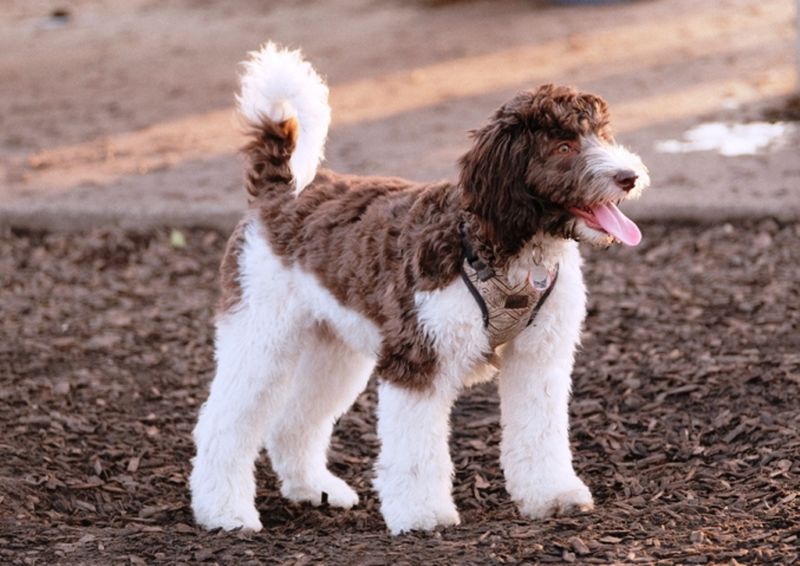A labradoodle is a cross between the Labrador retriever and the poodle. It takes traits from both breeds, and new puppy owners will quickly see this combination was chosen intentionally.
The Labrador retriever is an intelligent, loyal breed with an excellent temperament for nearly any family or living situation. Unfortunately, these dogs also shed a lot, which can be a hassle. It also makes a Labrador a poor choice for public social situations, such as outdoor dining at dog-friendly patios.
On the other hand, the poodle has a tight, curly coat that doesn’t shed as freely. Instead, the coat traps dirt, allergens, loose hair and other debris inside it. This means less shedding but also means daily brushing is required.

The poodle is also an intelligent breed that makes a perfect addition to most homes since it was bred to be a companion animal. They generally get along with other dogs, but this can vary based on the specific poodle’s temperament.
If you’re thinking of getting a labradoodle puppy, it’s essential to understand labradoodle life stages so you know what to expect. Any puppy is a lifelong commitment. Understanding what to expect at every life stage will help you prepare to give your cute little puppy a long, prosperous, happy life.
Average Labradoodle Lifespan
When considering becoming puppy parents, it’s essential to understand that each dog breed has a different average lifespan. A normal-sized labradoodle will live an average of 12 to 14 years. Smaller labradoodles resulting from a miniature or toy poodle crossbreed will generally live a little longer.
However, you must remember that this lifespan is only an average. There are plenty of labradoodles who live into their late teens.
Giving your new companion the best care starting when they’re a young puppy will ensure the best chances of longevity. A healthy diet, regular exercise and periodic vet visits are crucial to your labradoodle puppy living a long, healthy life.
Five Main Life Stages
Your dog’s life will cycle through five primary stages that, in many ways, are similar to those of humans. These main life stages include puppyhood, adolescence, adulthood, middle-aged and senior. Each life stage is discussed in more detail below.
1. Puppyhood
If you adopt a labradoodle puppy, this will be the first stage you get to witness. If you choose to adopt an older dog, of course, you won’t experience the joys and hardships of raising labradoodle puppies. A labradoodle puppy will remain in this life stage from birth until five or six months.
Birth to 7 Weeks
From birth until about seven weeks of age, labradoodle puppies stay close to their mother. They spend all their time eating, sleeping, growing and cuddling with their littermates.
As they get closer to seven weeks of age, they may begin exploring their world a little. However, it’s normal for a labradoodle puppy to not be very interested in humans or the outside world until it’s a little older.
7 Weeks to 4 Months
From about seven weeks of age until four months, your labradoodle puppy will be doing a lot of growing, physically and mentally. Around seven weeks of age, a labradoodle puppy will start becoming more interested in people. This is also when it begins forming bonds with you and other humans in the home or family.
These adorable puppies will become more playful and curious at about eight weeks old. This is when they’ll start getting into everything. You shouldn’t punish your puppy’s behavior during this time because it’s very impressionable. Instead, you want to create only positive experiences during this time to ensure it grows into a secure young adult dog.
At around 10 weeks, you’ll find your young pup is becoming more alert. This is the perfect time to start positive training techniques. Teaching your labradoodle puppy about action and reward now will benefit its lifelong training.
During this stage of puppy development, socialization is crucial. Now is the perfect time to take it to new places, introduce it to new people and provide it with new experiences.
4 to 6 Months
In this final stage of puppy development, your cute little puppy will begin acting a little more mature. The most important part of this stage of puppy development is that your pup becomes a free and independent thinker. With its curiosity at an all-time high, this is the perfect time to bring your new companion everywhere.
Socialization and bonding are other vital aspects of this stage of puppy development. Pet owners will find their puppy wants to be with them all the time and may become mildly anxious when separated from them. While being awakened in the middle of the night by puppy cries may be exhausting, it’s a normal part of puppy development that means you’re doing an excellent job with your little one.
2. Adolescence
Adolescence is essentially your labradoodle’s teenage years, which generally last from around five or six months until two years. Most of its time will be spent eating, sleeping or getting into trouble. So while it may feel like you have a “devil dog” at times, testing limits is a normal part of this stage.
Your growing canine should have lost its baby teeth, have all its adult teeth and be out of the biting stage it may have had during puppyhood. However, just because your labradoodle has its adult teeth doesn’t mean it’s lost its love of chewing.
Thanks to the Labrador genes, your labradoodle will always love to chew. You can stop destructive chewing behaviors by providing a chew toy or two (or 20) to keep it occupied.
Since this is essentially your labradoodle’s puberty phase, it can become unpredictable at times. It’ll also become bored quickly and likely be hyperactive when not sleeping. It may become territorial, but regular socialization can help ease these issues. During this phase, you’ll also want to transition from puppy food to adult dog food.
Adolescence isn’t all behavior issues. Your dog’s unique personality will become more defined, and it should be fully housebroken and paying better attention to you. Additionally, it’ll begin losing its awkwardness and becoming more coordinated. Your labradoodle will also begin showing quite a bit of strength, so continuing its training during this time is crucial.
Sexual Maturity
Although it isn’t something many puppy parents want to think about, adolescence is when your labradoodle will reach sexual maturity. If you plan on fixing your puppy, it’s best to do it at or before this time.
If you don’t plan on fixing your puppy, initially reaching sexual maturity can come with some distinct problems. Acting out, wandering and even behaving aggressively are all normal during this time.
However, it’s important to work regularly with threatening dogs and not ignore dogs that display aggression during this time. Working with them can ensure aggressive or unwanted behaviors don’t continue in perpetuity.
3. Adulthood
For a labradoodle, adulthood starts somewhere between two or three years of age and lasts until around its seventh birthday. During adulthood, labradoodles are at their prime. They’ll be calmer and more tranquil than they were as puppies. Also, they’ll be the fastest and strongest they’ll ever be during these years. Their adult coat will grow in, which may be thicker or denser than their puppy coat.
Just because your labradoodle has reached maturity doesn’t mean you can’t keep teaching it new and fun things. This breed is very intelligent and easy to train, so if you want to keep teaching it new tricks, you can.
Weight Management
Your labradoodle will reach its adult size between two and three years old. After that, you won’t have to worry about it getting any taller. Instead, you’ll want to make sure it doesn’t get fatter. Obesity can create a needless life or death situation for your labradoodle, so it’s important to watch its diet and weight throughout adulthood.
It’s normal for an adult labradoodle to fill out a little, whereas adolescent dogs tend to be skinnier. However, it’s important to teach good habits revolving around food to keep your labradoodle at a healthy weight. If you’re ever concerned about your dog’s weight, you should make an appointment with the vet. They can tell you if your dog is a normal size or needs diet and exercise.
4. Middle-Aged
Your doodle puppy will turn middle-aged around seven years old. This life stage is relatively brief and only lasts until the dog turns nine or 10.
During middle age, most dogs are still active and overall healthy. However, you’ll notice your dog starts to slow down a bit. It may exercise less and sleep a little more as it transitions between adulthood and its golden years.
A middle-aged dog may begin to develop some health problems, especially as it gets closer to its senior years. The primary issues of concern are obesity, joints and teeth.
The teeth and joints will become especially vulnerable during this stage, so you must take your dog for regular teeth cleaning and wellness visits. In addition, your vet may recommend supplements to protect the joints.
Keeping a close eye on your labradoodle’s weight is even more crucial now than during adulthood. If your dog does become overweight, it’s at a greater risk for health concerns. Extra weight will also place unnecessary additional stress on the joints and heart of your dog.
5. Senior
Your dog will officially be considered a senior from around nine to 10 years of age until the end of its life. During their golden years, your labradoodle will require extra care and attention. Health problems are most likely to occur during these years, and your vet may suggest two annual well visits instead of only one.
After 10 years of age, your dog will likely encounter issues staying warm. You might consider a heating blanket in their bed, keeping the house slightly warmer during winter or providing extra blankets to snuggle under. Your dog may also have problems with its eyesight.
The most common issue for senior labradoodles is their joints, which tend to ache as they get older. In addition, they may have mobility problems caused by sore and stiff joints. You’ll want to consider minor modifications to your home and lifestyle that make life more comfortable. For example, consider a ramp to help it get into the car or up your porch steps.

Common Health Problems
Although labradoodles are a generally healthy breed, there are several health issues they’re prone to. The chances of developing these conditions are low, but they’re worth noting. Developing one or more health problems could mean a shorter lifespan for your labradoodle.
A few of the most common health problems affecting labradoodle puppies or adults include:
- Allergies (usually to food)
- Ear infections (which can lead to hearing loss after repeat infections)
- Epilepsy
- Hip dysplasia
- Elbow dysplasia
- Progressive retinal atrophy (which can lead to blindness)
- Von Willebrand’s disease
- Addison’s disease
- Lymphoma
- Inflammatory bowel disease
Learn More About Your Labradoodle
Want to learn more about your labradoodle puppy or adult? Check out our website for extensive information specific to this breed. If you’re looking for help establishing good dog manners and creating a well-adjusted dog, contact us today for more information about professional training classes.
